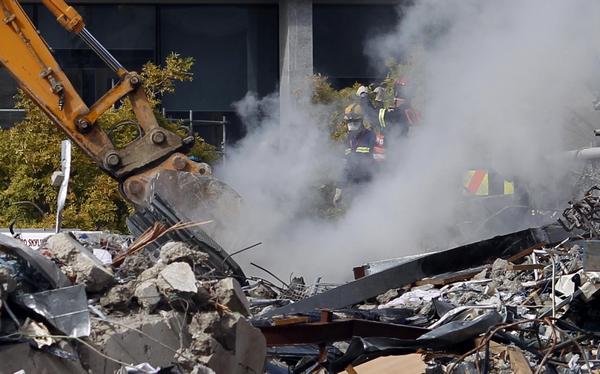Asia-Pacific
NZ earthquake toll at 76 dead, 238 missing
(Agemcies)
Updated: 2011-02-24 09:45
 |
Large Medium Small |
|
 Rescue workers search for signs of life in the rubble of CTV building in Christchurch Feb 24, 2011. [Photo/Agencies] |
CHRISTCHURCH, New Zealand -- Rescuers broadened their search of collapsed buildings in New Zealand's quake-shattered city of Christchurch on Thursday, after searches through the rubble of major downtown high-rises failed to find any more survivors.
Hundreds of foreign specialists in picking through dangerously unstable wreckage were arriving in Christchurch in response to Tuesday's 6.3 temblor, adding to local police and soldiers and allowing teams to head for smaller buildings not yet checked.
Searchers have brought 76 bodies to a temporary morgue in the city, and 238 people remain missing, police Superintendent Dave Cliff said. Officials have cautioned that not all of the people listed as missing should be assumed dead.
"We know there are more bodies yet to be recovered and we are in the process of doing that," Cliff told a news conference Thursday.
Prime Minister John Key has declared the quake a national disaster and analysts estimate its cost at up to $12 billion.
| ||||
"Now we've got the capability of going out and doing searches in areas where there may still be people trapped that hitherto we haven't been able to address," he said.
Police superintendent Russell Gibson said that the last survivor had been pulled out at 2 pm Wednesday, and no one had been found trapped in the rubble since.
Gibson said the operation had become one of body recovery, though he rejected suggestions that rescuers were abandoning hope of finding anyone alive.
"Yes, we are still looking for survivors," he said on National Radio. "There are pockets within a number of these buildings and, provided people haven't been crushed, there is no reason to suggest we will not continue to get survivors out of there."
The rescue effort had been concentrating on two office towers in downtown Christchurch, in which an unknown number of workers, students and others were caught when the temblor struck shortly before 1 pm and sent the buildings crumbling to the ground.
Thousands of other buildings were damaged across the city of some 350,000.
At one of the worst-hit offices, the Canterbury Television building, police said Wednesday they had given up hope of finding more survivors in the crumpled mass of concrete and steel, devastating families who had been waiting for news of loved ones believed to be inside.
Lizzy Manning, 18, and her 15-year-old brother Kent, were outside the building waiting for news of their mother, Donna, when a police officer approached them.
"I have some horrible news..." the officer began. The teens' faces crumpled, and their father wrapped them in an embrace as the officer gently broke the news that their mother was presumed dead along with everyone else trapped inside the building.
Hundreds of troops, police and emergency workers raced against time and aftershocks that threatened to collapse more buildings. They picked gingerly through the ruins, poking heat-seeking cameras into gaps between tumbles of bricks and sending sniffer dogs over concrete slabs.
Teams rushed in from Australia, the United States, Britain and Japan and elsewhere in Asia, along with a military field hospital and workers to help repair power, water and phone lines that were damaged in all corners of the city of some 350,000 people.
Gibson said work was still going on at the Canterbury Television building, but "the signs don't look good."
Many sections of the city lay in ruins, and police announced a nighttime curfew in a cordoned-off area of downtown to keep people away from dangerous buildings and to prevent crime. Six people had been arrested since the quake for burglary and theft, police said.
One of the city's tallest buildings, the 27-floor Hotel Grand Chancellor, was showing signs of buckling and could collapse, officials warned Wednesday. Authorities emptied the building and evacuated a two-block radius. It remained standing on Thursday.
JP Morgan analyst Michael Huttner conservatively estimated the insurance losses at $12 billion. That would be the most from a natural disaster since Hurricane Ike hit Texas and Louisiana in 2008, costing insurers $19 billion, according to the Insurance Information Institute.
Key said the New Zealand economy could withstand the impact of the quake, the second to strike Christchurch since September.
"Christchurch's economic activity will be much less for a while," he said. "The government will be doing everything it can to economically get Christchurch back on its feet."
Tuesday's quake was less powerful than the 7.1 temblor that struck before dawn on September 4 that damaged buildings but killed no one. Experts said Tuesday's quake was deadlier because it was closer to the city and because more people were about.
Christchurch's airport reopened Wednesday, and military planes were brought in to fly tourists to other cities.
Officials told people to avoid showering or even flushing toilets, saying the damaged sewer system was at risk of failing. School classes in the city were suspended, and residents advised to stay home.
Tanker trucks were stationed at 14 spots throughout the city where residents could come to fill buckets and bottles, civil defense officials said, and people asked to catch and save rainwater.
| 分享按钮 |



